What is the Difference Between Taboo & Fantasy?
Human desires and behaviors are incredibly complex, Often straddling the line between what is considered socially acceptable and what remains hidden in the recesses of our minds.
Taboo vs Fantasy: What’s the Difference?
Two concepts that frequently come up in discussions about human sexuality and psychology are taboos and fantasies. While they may seem similar, they are fundamentally different in how they manifest and what they represent. Taboos are societal boundaries—unwritten rules that dictate what is considered unacceptable or forbidden, often grounded in culture, morality, or law. Fantasies, on the other hand, exist within our imagination, a safe space where anything can happen, regardless of the rules we live by in the real world. In this blog, we’ll explore the key differences between taboos and fantasies, examining how each shapes our desires and behaviours in distinct ways.
Taboos
Taboos are dictated by society, often shaped by history, religion, ethics, and cultural values. They serve as boundaries that define what is acceptable or unacceptable within a given community. Violating taboos can lead to consequences like social exclusion, punishment, or moral judgment. Because taboos are external, they evolve over time—what was once taboo (such as women wearing pants or interracial marriage) may become normalized as societal values shift.
Fantasies
Fantasies, on the other hand, are internal and personal. They allow individuals to mentally explore ideas that might be impossible, unacceptable, or even dangerous in real life. Unlike taboos, fantasies don’t necessarily lead to actions; they provide an outlet for curiosity, creativity, or psychological processing. Someone might fantasize about a scenario they would never act on, either because of personal ethics or practical limitations.
The Key Difference
The key difference is that taboos exist in reality, while fantasies exist in the mind. A person can imagine something taboo without ever breaking societal rules. However, the intersection of the two can be complex—when fantasies involve taboo subjects, they might evoke strong emotional or moral reactions, even if they remain private. Some cultures and belief systems might even view certain fantasies as problematic, blurring the boundary between thought and action.
Ultimately, the divide highlights the tension between societal control and individual freedom of thought. The divide between taboos and fantasies is not just a simple separation between external rules and private thoughts—it reflects deeper aspects of human nature, psychology, and social structure.
The Social Function of Taboos
Taboos are more than just prohibitions; they serve a regulatory function in society. By defining certain behaviours as off-limits, societies create a sense of order, reinforcing moral codes, religious doctrines, and cultural identity. Taboos often serve to protect social cohesion, prevent harm, and maintain stability. For example:
• Sexual taboos – (e.g., incest, adultery) help regulate relationships and family structures.
• Religious taboos – (e.g., dietary restrictions, blasphemy) reinforce faith-based communities and traditions.
• Cultural taboos – (e.g., discussing death in some societies) shape collective attitudes toward life and mortality.
However, taboos can also be arbitrary, oppressive, or outdated. What is considered taboo varies across cultures and time periods—while some taboos remain universally condemned (e.g., murder, non-consensual acts), others shift based on societal evolution (e.g., attitudes toward LGBTQ+ identities, mental health discussions, or body modifications).
The Psychological Role of Fantasies
Fantasies, in contrast, are deeply personal and serve multiple psychological functions. They can be a source of pleasure, a way to explore desires, a means of coping with reality, or even a tool for self-discovery. Unlike taboos, which are imposed externally, fantasies are internally generated and allow individuals to experience ideas, emotions, or scenarios in a risk-free way.
• Act as a release valve – They provide an outlet for suppressed emotions, stress, or frustration.
• Aid self-exploration – They help individuals understand their own desires, fears, and boundaries.
• Enhance creativity – Many artistic, literary, and scientific breakthroughs stem from imaginative thinking.
• Improve well-being – Engaging in positive fantasies can boost mood and motivation.
Even when fantasies involve taboo subjects, they remain distinct from real-world behaviour. Most people can differentiate between thought and action, meaning having a fantasy about something taboo does not necessarily indicate a desire to act on it.
Where the Divide Blurs
While the distinction between taboos and fantasies is clear in theory, reality is more nuanced. Several factors can blur the line:
• Moral Judgment on Thoughts – In some cultures, merely thinking about a taboo subject can be seen as immoral or sinful, even if no action follows.
• Shifting Social Norms – What was once a taboo fantasy might become mainstream over time (e.g., fantasies about power dynamics in relationships, once considered inappropriate, have become widely explored in literature and media).
• The Fear of Thought-Action Fusion – Some people worry that fantasizing about a taboo subject means they are more likely to act on it, even though psychological research suggests that fantasy and behaviour are not always linked.
• The Internet & Anonymity – Online spaces allow people to share and discuss fantasies, sometimes challenging existing taboos and shifting public perception.
Conclusion
The divide between taboos and fantasies is a fundamental aspect of human society and psychology. Taboos regulate external behaviour to maintain social order, while fantasies provide a private space for personal exploration and expression. The tension between the two reflects the ongoing struggle between societal norms and individual freedom, highlighting how culture, morality, and human nature constantly evolve.


